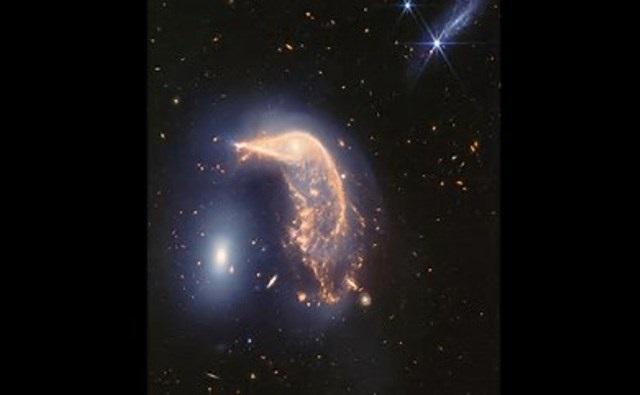NASA’s Webb Captures Stunning Cosmic Dance Of ‘Penguin and Egg’ Galaxies
Washington: NASA’s James Webb Space Telescope released a spectacular new view of a pair of intertwined galaxies in infrared light, nicknamed “the Penguin and the Egg” to mark Webb’s second anniversary. The two galaxies can be seen locked in a cosmic dance in space.
To honour Webb’s second anniversary on July 12, NASA released the stunning view of the interacting galaxy pair called Arp 142, captured by the James Webb Space Telescope. The image combines observations in near – and mid-infrared light, showing the two galaxies- the Penguin (NGC 2936) and the Egg (NGC 2937).
The cosmic dance features Webb’s observations, combining near-and mid-infrared light from Webb’s NIRCam (Near-Infrared Camera) and MIRI (Mid-Infrared Instrument) that show a blue haze representing the mingling of stars and gas.
NASA’s James Webb Space Telescope was launched on December 25, 2021, and began making scientific observations on July 12, 2022 onwards.
As observed by the astronomers, the Penguin and the Egg galaxies started interacting between 25 and 75 million years ago causing “fireworks” or new star formation in the Penguin galaxy. The galaxies have not consumed each other as they are approximately the same mass.
The Penguin, once a spiral galaxy, now appears with its galactic centre resembling an eye, its arms shaped like a beak, head, backbone, and a fanned-out tail. The Penguin is rich in gas and dust which is pulled by the Egg galaxy, forming stars.
Unlike the Penguin, the Egg’s small elliptical shape remained unconsumed and unchanged due to its identical mass. Since their first interaction, the celestial dance of the Penguin and the Egg continues.
According to NASA, the two galaxies are estimated to be about 100,000 light-years apart. For example, the Milky Way galaxy and our closest neighbour Andromeda Galaxy are about 2.5 million light-years apart. The two galaxies are expected to merge in about 4 billion years.


Comments are closed.